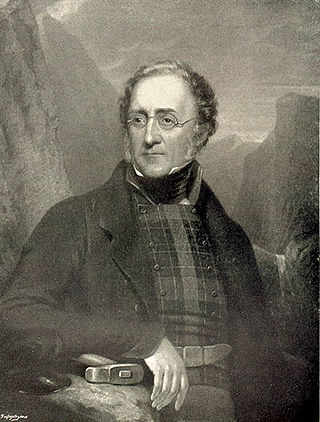
Sir Henry Thomas De la Beche KCB, FRS was an English geologist and palaeontologist, the first director of the Geological Survey of Great Britain, who helped pioneer early geological survey methods. He was the first President of the Palaeontographical Society.
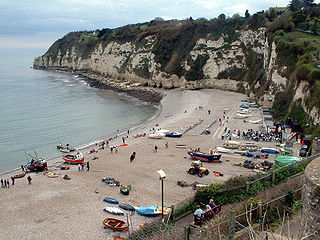
Beer is a seaside village and civil parish in the East Devon district of Devon, England. The village faces Lyme Bay and is a little over 1 mile (1.6 km) west of the town of Seaton. It is situated on the Jurassic Coast World Heritage Site and its picturesque cliffs, including Beer Head, form part of the South West Coast Path.

Heavitree is a historic village and former civil parish situated formerly outside the walls of the City of Exeter in Devon, England, and is today an eastern district of that city. It was formerly the first significant village outside the city on the road to London. It was the birthplace of the librarian Thomas Bodley, and the theologian Richard Hooker, and from the 16th century to 1818 was a site for executions within what is now the car park of the St Luke's Campus of the University of Exeter.
Colebrooke is a village and parish in Devon, England about 8 km west of Crediton. The main point of interest is the church and the connection to Henry Kingsley's novel The Recollections of Geoffry Hamlyn. Also Uncle Tom Cobley, of the folk song, signed his will at Pascoe House, but is buried 4 miles west at Spreyton. The champion Devon wrestler, Abraham Cann was born and buried here. He won the all-comers wrestling crown in London.

In Devon and Cornwall, tin coinage was a tax on refined tin, payable to the Duchy of Cornwall and administered in the Stannary Towns. The oldest surviving records of coinage show that it was collected in 1156. It was abolished by the Tin Duties Act 1838.
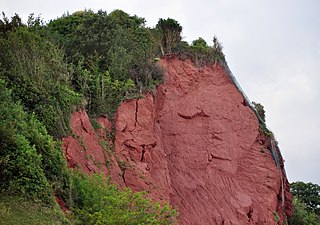
The New Red Sandstone, chiefly in British geology, is composed of beds of red sandstone and associated rocks laid down throughout the Permian to the end of the Triassic, that underlie the Jurassic-Triassic age Penarth Group. The name distinguishes it from the Old Red Sandstone which is largely Devonian in age, and with which it was originally confused due to their similar composition.
Head describes deposits consisting of fragmented material which, following weathering, have moved downslope through a process of solifluction. The term has been used by British geologists since the middle of the 19th century to describe such material in a range of different settings from flat hilltops to the bottoms of valleys. Areas identified as head include deposits of aeolian origin such as blown sand and loess, slope deposits such as gelifluctates and solifluctates, and recently eroded soil material, called colluvium. With geologists becoming more interested in studying the near-surface environment and its related processes, the term head is becoming obsolete.

Wonford is a former village, manor and ecclesiastical parish in Devon, England, now a part of the City of Exeter. The 13th century St Loye's Chapel situated within the parish now gives its name to the surrounding location. Wonford is situated next to the former parish of Heavitree, now both covered by the suburbs of Exeter.
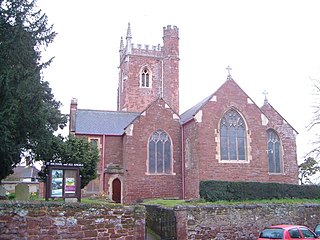
Alphington is a former manor and village, now a suburb of the City of Exeter in Devon. The ward of Alphington has a population of 8,250 according to the 2001 census, making it the third largest in Exeter, with the village itself accounting for about a quarter of this figure. The ward population increased to 8,682 at the 2011 census. It is surrounded on two sides by countryside, with the Marsh Barton trading estate to the east and Exeter City to the north. The Alphin Brook passes around the northern edge of Alphington. Alphington is on the south-western side of Exeter.

The Royal Devon and Exeter Hospital, and with a main site sometimes known as Wonford Hospital, is a large teaching hospital situated in Exeter, Devon, England, and is run by the Royal Devon University Healthcare NHS Foundation Trust.

Thorverton is a civil parish and village in Devon, England, about a mile west of the River Exe and 8 miles (13 km) north of Exeter. It is almost centrally located between Exeter and the towns of Tiverton, Cullompton and Crediton, and contains the hamlets of Yellowford and Raddon. The parish is surrounded, clockwise from the north, by the parishes of Bickleigh, Rewe, Nether Exe, Brampford Speke, Upton Pyne, Shobrooke, Stockleigh Pomeroy and Cadbury. Most of the eastern boundary of the parish is formed by the River Exe and the land rises westwards to 800 feet (240 m) at the border with Cadbury.
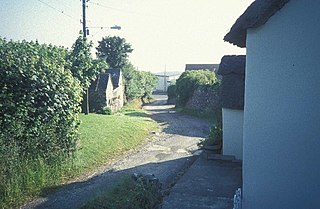
Petrockstowe is a small village and civil parish in the district of Torridge in Northern Devon, England. Its population in 2001 was 379, hardly different from the figure of 385 recorded in 1901. The southern boundary of the parish lies on the River Torridge, and it is surrounded, clockwise from the north, by the parishes of Peters Marland, Merton, Huish, Meeth, Highampton and Buckland Filleigh.
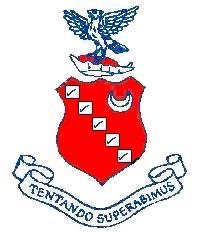
Hele's School was a boys' grammar school, and latterly a comprehensive school, in the city of Exeter, Devon, England.

Doddiscombsleigh is a small settlement in Devon, England. It is 5 miles (8 km) southwest of the city of Exeter and one mile East of the River Teign and the Teign Valley. Along with a few other places in Devon, it is one of the longest place names in England with 16 letters.

Beer Quarry Caves is a man-made limestone underground complex located about a mile west of the village of Beer, Devon, and the main source in England for beer stone. The tunnels resulted from 2,000 years of quarrying beer stone, which was particularly favoured for cathedral and church features such as door and window surrounds because of its colour and workability for carving. Stone from the quarry was used in the construction of several of southern England's ancient cathedrals and a number of other important buildings as well as for many town and village churches, and for some buildings in the United States. Extraction was particularly intense during the Middle Ages, but continued until the 1920s. An adit to another set of workings can be seen from the South West Coast Path east of Branscombe, having been exposed by a landslip in the late 18th century. The quarry is part of the Jurassic Coast, and is a Site of Special Scientific Interest (SSSI).
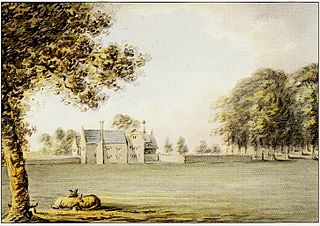
Cowick is a suburb of the City of Exeter in Devon. Historically it was a manor situated in the parish of St Thomas, Exeter, within the hundred of Wonford. It was formerly the site of a Benedictine monastery.

St Martin's Church in Cathedral Close, Exeter, Devon, England was built in the 15th century. It is recorded in the National Heritage List for England as a designated Grade I listed building, and is now a redundant church in the care of the Churches Conservation Trust. It was vested in the Trust on 1 August 1995.

The Upper Greensand Formation is a Cretaceous formation of Albian to Cenomanian in age, found within the Wessex Basin and parts of the Weald Basin in southern England. It overlies the Gault Clay and underlies the Chalk Group. It varies in thickness from zero to 75 m. It is predominantly a glauconitic fine-grained sandstone, locally becoming silty. Fragmentary dinosaur remains, such as those assigned to Iuticosaurus, have been recovered from this formation. It has been quarried as a building stone from Roman times, and used in London and the area of its outcrop from Devon to East Sussex.

The Church of St Michael and All Angels is the main Church of England parish church for the suburb of Heavitree, located in the city of Exeter, Devon. The present building is a large and imposing Gothic Revival structure dating back to the 19th century but there has been a church on the site since Saxon times. Designated as a Grade II* listed building by Historic England, the church is notable for its Victorian architecture, tall tower and proximity to the 'Heavitree Yew', an ancient common yew tree within the churchyard amongst the oldest in the county.
The Heavitree isolation hospital, also for a time known as the Exeter Corporation Tuberculosis Sanatorium, was a small pulmonary tuberculosis sanatorium located on Hollow Lane, Exeter, United Kingdom. The site is a few hundred metres to the west of the Whipton Hospital.

















